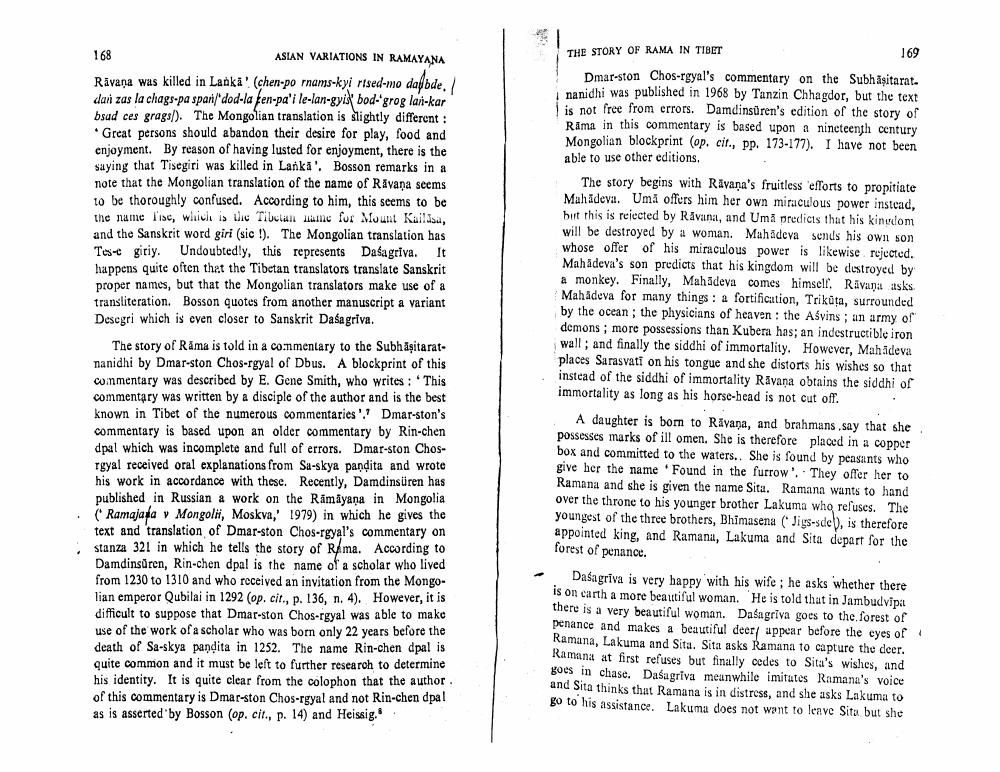Book Title: Story Of Rama In Tibet Author(s): J W De Jong Publisher: J W De Jong View full book textPage 4
________________ . 168 ASIAN VARIATIONS IN RAMAYANA Ravana was killed in Lanka (chen-po rnams-kyi rised-mo dafbde. dan zas la chags-pa span dod-la fen-pa'i le-lan-gyis bod-'grog lan-kar bsad ces grags/). The Mongolian translation is slightly different: Great persons should abandon their desire for play, food and enjoyment. By reason of having lusted for enjoyment, there is the saying that Tisegiri was killed in Lanka'. Bosson remarks in a note that the Mongolian translation of the name of Ravana seems to be thoroughly confused. According to him, this seems to be the name lise, which is the Tibetan name for Mount Kailasa, and the Sanskrit word giri (sic!). The Mongolian translation has Tes-e giriy. Undoubtedly, this represents Datagriva. It happens quite often that the Tibetan translators translate Sanskrit proper names, but that the Mongolian translators make use of a transliteration. Bosson quotes from another manuscript a variant Desegri which is even closer to Sanskrit Dasagriva. The story of Rama is told in a commentary to the Subhasitaratnanidhi by Dmar-ston Chos-rgyal of Dbus. A blockprint of this commentary was described by E. Gene Smith, who writes: This commentary was written by a disciple of the author and is the best known in Tibet of the numerous commentaries'. Dmar-ston's commentary is based upon an older commentary by Rin-chen dpal which was incomplete and full of errors. Dmar-ston Chosrgyal received oral explanations from Sa-skya pandita and wrote his work in accordance with these. Recently, Damdinsüren has published in Russian a work on the Rāmāyaṇa in Mongolia (Ramajala v Mongolii, Moskva,' 1979) in which he gives the text and translation of Dmar-ston Chos-rgyal's commentary on stanza 321 in which he tells the story of Rama. According to Damdinsüren, Rin-chen dpal is the name of a scholar who lived from 1230 to 1310 and who received an invitation from the Mongolian emperor Qubilai in 1292 (op. cit., p. 136, n. 4). However, it is difficult to suppose that Dmar-ston Chos-rgyal was able to make use of the work of a scholar who was born only 22 years before the death of Sa-skya pandita in 1252. The name Rin-chen dpal is quite common and it must be left to further research to determine his identity. It is quite clear from the colophon that the author of this commentary is Dmar-ston Chos-rgyal and not Rin-chen dpal as is asserted by Bosson (op. cit., p. 14) and Heissig. THE STORY OF RAMA IN TIBET Dmar-ston Chos-rgyal's commentary on the Subhäṣitarat. nanidhi was published in 1968 by Tanzin Chhagdor, but the text is not free from errors. Damdinsüren's edition of the story of Rama in this commentary is based upon a nineteenth century Mongolian blockprint (op. cit., pp. 173-177). I have not been able to use other editions. 169 The story begins with Ravana's fruitless efforts to propitiate Mahadeva. Uma offers him her own miraculous power instead, but this is rejected by Ravana, and Uma predicts that his kingdom will be destroyed by a woman. Mahadeva sends his own son whose offer of his miraculous power is likewise rejected.. Mahadeva's son predicts that his kingdom will be destroyed by a monkey. Finally, Mahadeva comes himself. Ravana asks Mahadeva for many things: a fortification, Triküta, surrounded by the ocean; the physicians of heaven: the Aśvins; an army of demons; more possessions than Kubera has; an indestructible iron wall; and finally the siddhi of immortality. However, Mahadeva places Sarasvati on his tongue and she distorts his wishes so that instead of the siddhi of immortality Ravana obtains the siddhi of immortality as long as his horse-head is not cut off. A daughter is born to Ravana, and brahmans say that she possesses marks of ill omen. She is therefore placed in a copper box and committed to the waters.. She is found by peasants who give her the name Found in the furrow'. They offer her to Ramana and she is given the name Sita. Ramana wants to hand over the throne to his younger brother Lakuma who refuses. The youngest of the three brothers, Bhimasena ( Jigs-sde), is therefore appointed king, and Ramana, Lakuma and Sita depart for the forest of penance. Dasagrīva is very happy with his wife; he asks whether there is on earth a more beautiful woman. He is told that in Jambudvipa there is a very beautiful woman. Dasagrīva goes to the forest of penance and makes a beautiful deer appear before the eyes of Ramana, Lakuma and Sita. Sita asks Ramana to capture the deer. Ramana at first refuses but finally cedes to Sita's wishes, and goes in chase. Daśagriva meanwhile imitates Ramana's voice and Sita thinks that Ramana is in distress, and she asks Lakuma to go to his assistance. Lakuma does not want to leave Sita but shePage Navigation
1 2 3 4 5 6 7 8 9 10 11
